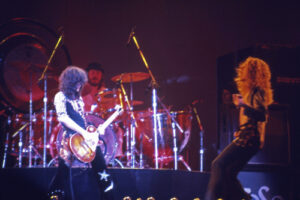Our Top 10 Gary Moore Songs list showcases the talent of one of the most exceptional rock and roll guitarists to have ever performed on stage. Gary Moore is often overlooked in discussions about the top guitarists, which is regrettable. For those familiar with his music, it’s clear that he was one of the most dynamic and brilliant guitarists to have ever lived, combining Eric Clapton’s magnificent technique with the soul and spirit of Stevie Ray Vaughan.
Gary Moore embarked on his solo career in the late 1970s after playing with various bands and honing his skills over the years. Influenced by his father from a young age, Moore’s musical journey began when he was invited to sing on stage with a showband at a gig organized by his father at the age of six. Four years later, his father bought him a guitar, with which he developed a profound connection. Moore later moved to Dublin, where he joined the Irish band Skid Row, before eventually leaving to start his solo career.
In 1974, Gary Moore joined the legendary rock band Thin Lizzy, stepping in for Brian Robertson, who had injured his hand. Although Robertson eventually returned and later left the band, Moore replaced him once again. However, Moore found Thin Lizzy’s heavy partying lifestyle unsuitable and chose not to become a permanent member, leaving the band once more. Relocating to London, Moore signed with Virgin Records and released the album “Corridors of Power.” Although it wasn’t a major success, the album did chart on the Billboard Top 200 album charts and featured notable musicians such as Whitesnake bassist Neil Murray and Deep Purple drummer Ian Paice.
One of Gary Moore’s most acclaimed works is his legendary album “Still Got the Blues.” This album is often cited by classic rock guitarists as one of the most influential albums of the classic rock era for rock and roll guitar players. Released in 1990, it stood in sharp contrast to the emerging grunge scene.
Our Top 10 Gary Moore songs list honors the artistry of one of rock music’s finest guitarists. Gary Moore was so highly esteemed that even renowned guitar manufacturers Gibson and Fender paid tribute to him with signature model guitars. For those not yet acquainted with Gary Moore’s music, this list serves as an introduction to one of the all-time great guitarists.
# 10 – Cold Day in Hell
Kicking off our top 10 Gary Moore songs list is the electrifying track “Cold Day in Hell” from his 1992 album, After Hours. Right from the start, this song captures the essence of rock and roll blues with its dynamic horn section and Gary Moore’s intense guitar solo, showcasing his exceptional prowess. The influence of blues legend B.B. King is palpable in Moore’s playing, and fittingly, King himself contributes to the After Hours album. Additionally, the album boasts a collaboration with the renowned blues guitarist Albert Collins. For enthusiasts of blues guitar, After Hours is an essential addition to your collection.
# 9 – The Prophet
Back to the Blues marked a striking return for Gary Moore to the electric blues sounds that once propelled him to fame. In this pivotal album, “The Prophet” stands out as a track that showcases Moore’s unparalleled skill and the reason behind his recognition with signature models from guitar giants Gibson and Fender. The emotional depth and intensity of the guitar riffs in this song are a testament to Moore’s mastery.
The album, released in 2001, represents Moore’s thirteenth solo venture, rekindling the electric blues genre he became renowned for in the early ’90s, after experimenting with different musical styles. This project was also the first to feature Darrin Mooney on drums, who would become a regular collaborator on future albums, the Scars project, and several live recordings.
The artwork of the album features Gary Moore at the Therapia Lane Tram Depot in Croydon, setting a thematic tone for the blues journey within. The line-up for this album included Moore on guitar and vocals, supported by Vic Martin on keyboards, Pete Rees on bass, and Darrin Mooney behind the drums, creating a solid foundation for Moore’s blues exploration.
# 8 – Over the Hills and Far Away
“Over the Hills and Far Away” is a notable track by Northern Irish musician Gary Moore, launched in December 1986 as the lead single from his sixth solo endeavor, Wild Frontier. The song enjoyed considerable success, notably peaking at number 20 on the UK Singles Chart and achieving number one positions in both Finland and Norway, illustrating its particular resonance in the Nordic regions.
The track is distinguished by its collaboration with The Chieftains, a feature that extends to the music video and a notable performance on a TV show celebrating the group’s 25th anniversary in 1988. The single’s B-side, “Crying in the Shadows,” also penned by Moore and produced by Mike Stone, found its own unique path, being covered by Japanese artist Minako Honda under the title “The Cross (Ai No Jujika)” featuring Moore on guitar. Interestingly, Moore’s own rendition of “Crying in the Shadows” was released as a single in Japan, with “Once in a Lifetime” from the Run for Cover album as its B-side.
The narrative of “Over the Hills and Far Away” delves into the story of a man unjustly convicted of armed robbery, a situation complicated by his silence regarding his alibi to protect the identity of his best friend’s wife, with whom he was involved. This storyline draws a parallel to the 1959 country ballad “Long Black Veil,” sharing a theme of wrongful conviction intertwined with themes of loyalty, love, and sacrifice.
Wild Frontier, the album housing “Over the Hills and Far Away,” was released on March 2 1987 and is infused with themes related to Ireland, a nod to Moore’s heritage and his reflections following a 1985 visit to Belfast. The album serves as a tribute to Phil Lynott, Moore’s friend and former Thin Lizzy bandmate, who passed away in 1986, with the album bearing a dedication “For Philip” on its rear cover.
# 7 – Led Clones
Prepare to lace up your rock ‘n’ roll kicks for this one—it’s a high-voltage ride. When you’re delving into some robust, hard-hitting tunes, who better to helm the vocals than the legendary Ozzy Osbourne himself? The track in question is cleverly named to hint at its musical homage, echoing the iconic vibes of Led Zeppelin’s “Kashmir” in its riffing during the verses. But the nods don’t stop there; the lyrics are peppered with references to Led Zeppelin’s own repertoire, and there’s even a moment where Ozzy channels Robert Plant’s distinctive vocal flair. It’s a spirited, tongue-in-cheek tribute through and through.
After the War, the album that houses this gem, is Gary Moore’s seventh solo studio venture, making its mark on the music scene on January 25 1989. The lineup for this album is nothing short of stellar, featuring Gary Moore himself on guitars and lead vocals. Neil Carter lends his skills on the keyboards and backing vocals, while Bob Daisley provides the bass grooves, and the legendary Cozy Powell holds down the fort on drums. It’s a powerhouse assembly for a track and album that rock with reverence and raucous energy.
#6 – Empty Rooms
The sounds of Gary Moore’s lead guitar playing at the song’s start will instantly put you in a trance. Ranked at number six among the top 10 Gary Moore tracks, this ballad hails from his 1983 masterpiece, Victims of the Future. The song resonates deeply with anyone who has navigated the turbulent waters of a failed love affair, its poignant lyrics and soul-stirring melody striking a universal chord.
“Empty Rooms” is a masterclass in slow blues, distinguished by a signature Gary Moore guitar solo around the three-minute mark that serves as the emotional crescendo of the piece. This track not only rounds off the second side of the album with a powerful finale but also emerged as the third single, further cementing its place in Moore’s illustrious catalog.
Victims of the Future, marking Moore’s fourth solo studio album, was unveiled to the world on 30 January 1984, showcasing a rich tapestry of musical talent. Alongside Moore’s unparalleled prowess on guitar and vocals, the album features Ian Paice with his dynamic drumming. Neil Carter and Neil Murray contribute their talents on keyboards, vocals, and bass guitar, respectively, creating a harmonious blend that underpins the emotive depth of “Empty Rooms” and the entire album.
# 5 – Preacher Man Blues
Landing squarely in the middle of our top Gary Moore tracks is the fiery “Preacher Man Blues,” a standout piece from Bad for You Baby. This album, the seventeenth solo endeavor by the esteemed Northern Irish blues musician Gary Moore, holds the distinction of being the final studio work released during his lifetime, showcasing his undiminished talent and passion for the blues.
In “Preacher Man Blues,” Moore’s artistry shines bright as he takes on vocals, guitar, and even harmonica, infusing the track with his signature intensity and depth. The song is bolstered by the solid foundation laid down by Pete Rees on bass and Vic Martin on keyboards, while the inclusion of Otis Taylor on banjo adds a unique texture that complements Moore’s bluesy riffing.
Adding further dynamism to the track, Cassie Taylor lends her vocal talents to the background, enriching the sonic landscape alongside Moore’s powerful delivery. Sam Kelly’s drumming punctuates the arrangement, driving the rhythm forward and ensuring “Preacher Man Blues” burns brightly as a testament to Gary Moore’s enduring legacy in the blues genre.
#4 – The Loner
To stake a claim for Gary Moore as one of classic rock’s premier guitarists, one need look no further than the mesmerizing instrumental “The Loner.” This track, a highlight from his sixth solo studio album Wild Frontier released in 1987, showcases Moore’s guitar prowess in all its glory, delivering a performance that’s both technically brilliant and emotionally profound.
“The Loner” is a tour de force of expressive guitar work, with Moore weaving a tapestry of melodic lines and intricate solos that speak volumes without uttering a single word. The depth of emotion conveyed through his playing on this track could easily make the case for Moore’s inclusion among the elite guitarists in rock history.
While the composition is undeniably stirring, some listeners might find themselves wishing for the dynamic touch of a live drummer to complement Moore’s soulful playing, despite Roland Kerridge’s adept drum programming providing the rhythmic backbone.
Alongside Moore’s guitar, Neil Carter contributes keyboards and backing vocals, adding layers to the track’s atmospheric quality. Bob Daisley’s bass underpins the arrangement, grounding the ethereal guitar lines with a solid foundation. Together, the ensemble crafts a piece that is not just a showcase for Moore’s technical skill, but a heartfelt expression of his artistic vision.
#3 – Out in The Fields
Securing the third spot on our top 10 Gary Moore songs is “Out in The Fields,” a standout track from his 1985 album Run for Cover. This commercial rock ballad unites the talents of two of Ireland’s most celebrated music icons, Gary Moore and Phil Lynott. Lynott, the iconic frontman of Thin Lizzy, joined forces with Moore to deliver lead vocals on this powerful anti-war anthem, which soared to number five on the UK Singles Charts. The collaboration between these two legendary figures produced a track that’s not only musically compelling but also charged with a poignant message.
Run for Cover is Moore’s fifth solo studio album and is often cited as his breakthrough project. Released on 2 September 1985, the album features “Out in The Fields” as a key single, spotlighting the enduring partnership between Moore and Lynott, former Thin Lizzy bandmates. The song, penned by Moore, addresses the turmoil of the Troubles in Northern Ireland, offering a poignant commentary set against a backdrop of driving rock melodies.
The commercial success of “Out in The Fields” was significant, reaching number three on the Irish Singles Chart and becoming the highest-charting single for both Moore and Lynott in the UK. This collaboration stands as one of the final recordings by Phil Lynott before his untimely passing in January 1986. The track features Gary Moore on guitars and lead vocals, with Phil Lynott on lead vocals and bass, supported by Andy Richards and Don Airey on keyboards, and Charlie Morgan providing both live and electronic drumming, crafting a powerful sonic experience that encapsulates the fervor and intensity of the era.
# 2 – Parisienne Walkways
Taking the second position in our Gary Moore anthology is the spellbinding “Parisienne Walkways,” a track that evokes the soulful vibes of Santana’s “Europa” with its poignant guitar solos. Moore’s performance on this track is profoundly moving, showcasing his exceptional ability to convey deep emotions through his guitar. “Parisienne Walkways” exists in numerous renditions, each capturing a different essence of Moore’s artistry, yet it’s widely regarded that the definitive version of this masterpiece resides within the Blues Alive album, released in 1983.
Originally unveiled as part of his Back on the Streets album in 1978, “Parisienne Walkways” has since become a quintessential piece in Moore’s repertoire, cherished by fans and critics alike. One of the song’s most unforgettable moments occurs around the two-minute-and-twenty-five-second mark, where Moore sustains a guitar note with such intensity and emotion that it’s often hailed as one of the most iconic moments in rock history. This single note, held for an astonishing duration, encapsulates the sheer power and emotive depth of Moore’s musicianship,
# 1- Still Got the Blues (For You)
Topping our Gary Moore song compilation is the iconic “Still Got the Blues (For You),” a track that captures the essence of Moore’s unparalleled talent and emotional depth. Featured on his 1990 album, also named Still Got the Blues (For You), this song stands as a testament to Moore’s ability to transcend the typical boundaries of pop music to create something truly timeless. Remarkably, it became his first and only track to penetrate the Billboard Top 100, marking a significant milestone in his career.
“Still Got the Blues (For You)” masterfully melds the expressiveness of B.B. King, the distinctive flair of Santana, and the intensity of Stevie Ray Vaughan, culminating in a piece that showcases guitar virtuosity at its peak. Beyond the mesmerizing guitar work, Moore’s soul-stirring vocals imbue the song with a profound sense of longing and heartache, making it a deeply moving experience.
The emotional crescendo of the song is undoubtedly Moore’s guitar solo, a powerful display of technical prowess and raw emotion that could easily move listeners to tears. This solo is more than just a highlight of the song; it’s a moment where Moore’s guitar truly sings, conveying feelings that words alone could never express. “Still Got the Blues (For You)” is not just a song; it’s an emotional journey, and its placement at the pinnacle of our list reflects its enduring impact and the indelible mark Gary Moore has left on the world of music.
Feature Photo at top of page: LivePict.com, CC BY-SA 3.0 <https://creativecommons.org/licenses/by-sa/3.0>, via Wikimedia Commons





































Superb list – Gary Moore is criminally overlooked by the general populace, but embraced as a virtuoso by his fans, followers, and peers.
Although a cover of the great Roy Buchanan, Gary Moore’s tribute of “The Messiah Will Come Again” is (in my opinion) a masterpiece, which I would put in the top
3 of this article’s listing.
For an aural treat, check out Gary Moore’s 1989 version of “The Messiah Will Come Again” – especially the live versions (i.e. Montreux), available on You Tube.
Gary Moore, a fret master himself, respectfully referenced Roy Buchanan as a major influence on his techniques.
Support Live Local Music.